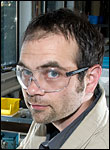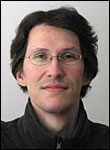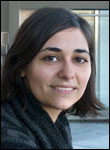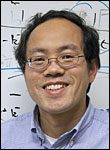BNL Scientists/Users Receive DOE Early Career Research Program Grants
March 4, 2010
Adrian Gozar, an associate scientist in BNL’s Condensed Matter Physics & Materials Science Department, and three university scientists who use BNL’s facilities — Marivi Fernandez-Serra, Denes Molnar and Feng Yuan — have been chosen to receive five-year research grants under the DOE Early Career Research Program. They are among 69 researchers from across the nation who will receive up to $85 million in funding under the American Recovery and Reinvestment Act. The new program is designed to bolster the nation’s scientific workforce by providing support to exceptional researchers during their crucial early years, when many scientists do their most formative work.
Under the program, university-based researchers will receive at least $150,000 per year to cover summer salary and research expenses. For researchers based at DOE national laboratories, grants will be at least $500,000 per year to cover year-round salary plus research expenses.

Adrian Gozar
Adrian Gozar – funded by the Office of Basic Energy Sciences for “Investigation of the role of inhomogeneities and phase segregation on correlated electron dynamics by optical spectroscopy and nano-imaging.”
The goal of Gozar’s research is to understand the optical properties of correlated electronic systems – systems that are on the brink of several competing instabilities, or phases. For example, high-temperature superconductors and colossal magnetoresistive oxides are examples of such systems. Gozar will investigate differences in these materials at transitions between insulating, metallic and superconducting phases.
Gozar will use specially designed optical spectroscopy and nano-imaging techniques to probe materials at the scale of a nanometer, or a billionth of a meter. An understanding of the structural properties of these materials as they transition between different phases is a crucial step in determining if their functional properties can be improved for potential applications.
Gozar earned a B.S. and M.S. in physics from the University of Bucharest, Romania, in 1997 and 1998, respectively, and a Ph.D. in physics from the University at Urbana-Champaign, in 2004. He joined BNL as a Distinguished Goldhaber Fellow in 2004, became an assistant scientist in 2007, and an associate scientist in 2009.

Denes Molnar
Denes Molnar – funded by the Office of Nuclear Physics for “Viscosity and equation of state of hot and dense QCD matter.”
Molnar studies heavy ion collisions at BNL’s Relativistic Heavy Ion Collider (RHIC), where matter known a quark-gluon plasma, which is believed to have existed just for microseconds after the Big Bang, heats up to 4 trillion degrees Celsius – the hottest temperature ever reached in a laboratory and 250,000 times hotter than the center of the sun. Exciting recent results from RHIC indicate unique properties of quark-gluon plasma, such as surprisingly low viscosity. However, these results rely on simplified models of collision dynamics. The focus of Molnar’s research will be to greatly improve the theoretical description of the collision dynamics, and thereby enable a reliable determination of the properties of the plasma.
After attending Eötvös University in Budapest, Hungary, for his undergraduate physics education from 1992 to 1995, Molnar earned a M.Sc. in physics from the University of Bergen in Bergen, Norway in 1997, and he then came to the U.S., where he earned a Ph.D. in physics from Columbia University in 2002. He did postgraduate research at The Ohio State University from 2002 to 2005, and he received a joint appointment as assistant professor at Purdue University and RIKEN fellow in the RIKEN BNL Research Center in 2005.

Marivi Fernandez-Serra
Marivi Fernandez-Serra – funded by the Office of Basic Energy Sciences for “First Principles Modeling of Metal-Electrolyte Systems: A Novel Approach to the Study of the Electrochemical Interface.”
Fernandez-Serra, who is an assistant professor in the Physics and Astronomy Department at Stony Brook University (SBU), uses New York Blue, a supercomputer that is the centerpiece of the Brookhaven/Stony Brook-led New York Center for Computational Sciences, and a computer cluster at the Center for Functional Nanomaterials for her research on electrochemical interfaces. These sophisticated computing facilities at Brookhaven enable her to make high-level quantum mechanical calculations to study the dynamics of atoms and electrons on liquid-metal interfaces on a timescale of less than a billionth of a second. Understanding the physics and chemistry of these interfaces is important for designing efficient fuel cells.
After earning a B.S. and M.S. in physics and condensed matter physics in 1999 and 2001, respectively, from Universidad Autónoma de Madrid, Spain, Fernandez-Serra earned a Ph.D. in physics in 2004 from Cambridge University. She was a postdoctoral associate at Universite Claude Bernard Lyon 1, Lyon, France, from 2005 to 2006, and at the Centre Européen de Calcul Atomique et Moléculaire, also in Lyon, France, from 2006 to 2008. She joined SBU as an assistant professor in 2008.

Feng Yuan
Feng Yuan – funded by the Office of Nuclear Physics for “Theoretical investigation of Nucleon Structure.”
Understanding the structure of the nucleon — the neutron and proton that make up the atomic nucleus – is a fundamental focus of subatomic physics and has been the subject of intensive study over the last several years. Yuan has proposed an investigation of nucleon structure using quantum chromodynamics, a theoretical framework that requires complex mathematical computations. His research may reveal important information about a proton’s spin, an intrinsic property of subatomic particles that is similar to earth spinning on its access. These studies are relevant to RHIC’s polarized proton program and the future electron-ion collider, called eRHIC, which might make it possible to discover a new state of nuclear matter.
Yuan earned a B.S. and Ph.D. in physics from Peking University, Bejing, in 1995 and 2000, respectively. He was a postdoctoral research associate at Heidelberg University from 2000 to 2002, at the University of Maryland at College Park from 2002 to 2004, and at the RIKEN/BNL Research Center at BNL from 2004 to 2007. Since 2007, he has been a Division Fellow and RHIC Fellow at Lawrence Berkeley National Laboratory.
2010-1610 | INT/EXT | Newsroom









